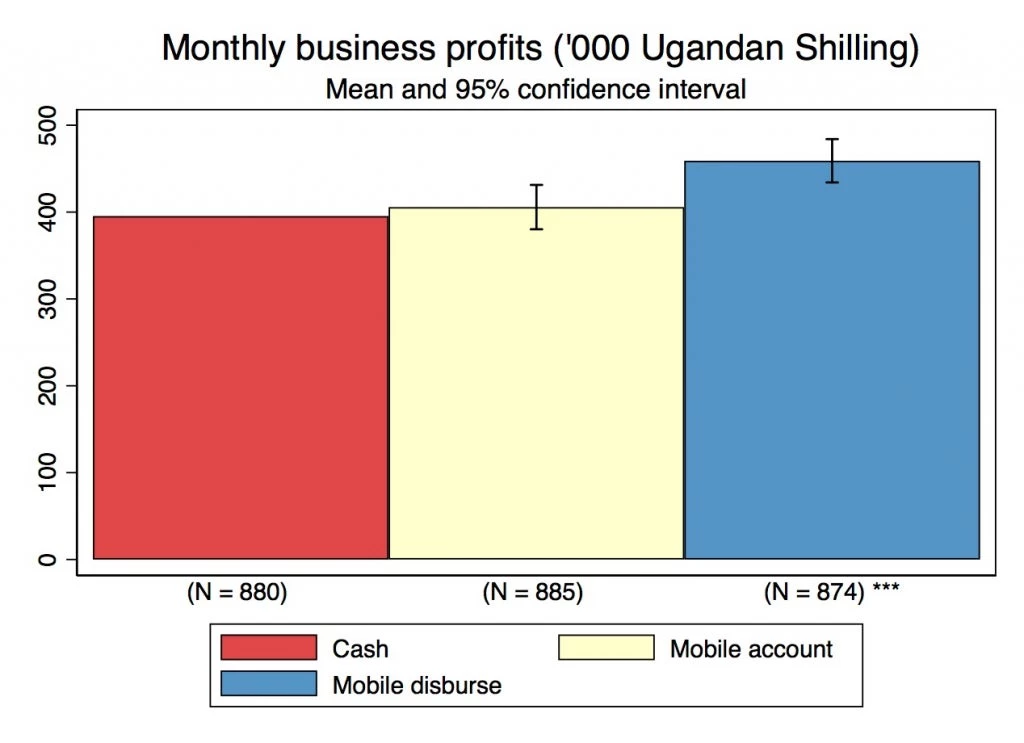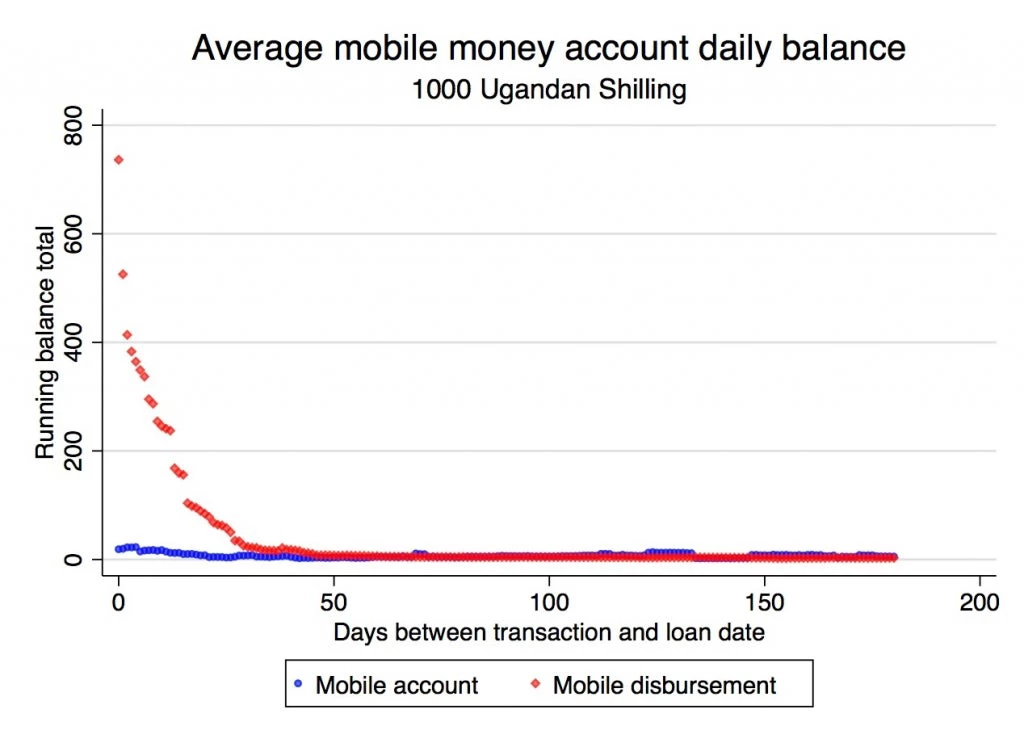This is the first in this year’s series of posts by PhD students on the job market.
Most working women in developing countries are self-employed, running their own micro-enterprises. These enterprises often make little profit for their owners and do not grow. This is despite evidence showing that the rate of return to capital for small enterprises is very high. Social pressure to share money is one potential dampener of business investment, particularly for women. As such, women may struggle to channel cash funds into their business. However, social-sharing norms have been shown to depend on the form that money is in, with cash subject to sharing pressure, while savings in a bank account or in a business not subject to such pressures. This suggests that changing the form that business loans are given in, away from cash, could facilitate the growth of female-owned enterprises.
In my job market paper, I examine whether changing the form that a microfinance loan is disbursed in, from cash to directly onto a digital account, enables higher investment in women’s businesses and increases their profits as a result. Additionally, I test whether household sharing pressure can explain why digital loans enable more female enterprise growth.
I do this using a field experiment of 3,000 female microfinance clients of BRAC, one of the largest NGOs in the world, in urban Uganda. In this experiment, women taking out a loan from BRAC were individually randomised equally into one of three treatments:
Mobile Account: labelled mobile money account for the business + loan as cash
Mobile Disbursement: labelled mobile money account for the business + loan on the mobile money account
Cash: loan as cash
No other features of the microfinance loan products were changed, and repayments continued to be made weekly at group meetings in cash. The average loan size was $400, repaid over 9 months at a 40% annual interest rate. All of these clients already had a business verified by BRAC, and the majority of the businesses were inventory focused, selling fruit and vegetables, dried goods and reselling clothes and shoes. Prior to receiving the loan, on average, the women made $100 a month of profit in their business, 40% of household income. Two-thirds of the women were married, and for married women, 60% of their spouses also had a business of their own. Note that 97% of my sample had used mobile money before, so the introduction of a new technology is not something I’m examining here.
Receiving a loan on a mobile money account improves business and household outcomes
I find that 8 months after the microfinance loan was disbursed, those in the Mobile Disbursement treatment make 15% higher profits and have 11% higher values of business capital invested in their businesses, compared to the control Cash group (see Figure 1). This improvement in business performance translates into benefits for the household as a whole, with both income and consumption 7% higher in the Mobile Disbursement group compared to the Cash group. I do not find any effects from the Mobile Account treatment, with the mobile money account only used by 13% of the women given them. Hence, the loan must be deposited onto the mobile money account for there to be beneficial impacts.
Figure 1: Profits increased more when loans were disbursed as mobile money rather than cash
Using administrative data from the mobile money provider, I see that the mobile money accounts were primarily used to store the loan safely. The balance on the account was drawn down over time in multiple withdrawals as needed for business investment, rather than the accounts being used for deposits (see figure 2). As a result, more of the loan ends up in the woman’s business. I examine the reasons for this below.
Figure 2: Loans given as mobile money were drawn down over time, with few deposits made
Loans disbursed on a mobile money account are less subject to sharing pressure from the spouse
I examine whether self-control difficulties or sharing pressure is the mechanism which explains my findings by looking at heterogenous treatment effects. I do this by constructing pre-specified indices of self-control difficulties and sharing pressure at baseline and splitting the sample by those above and below the median of the index. The self-control index captures hyperbolic time preference and impatience, measured by an incentivised task, and whether the woman was saving for her business. The sharing pressure index captures an incentivised measure of willingness to hide money from the spouse, whether the woman is married, whether another household member has a business and a self-reported measure of pressure to share money.
I see strong heterogeneity for those above the median in the sharing pressure index, with women who experienced sharing pressure at baseline seeing a 24% increase in business investment and 25% increase in profit from the Mobile Disbursement treatment. There is no effect of the Mobile Disbursement treatment for those who didn’t experience sharing pressure at baseline. I also see no heterogeneity by the self-control index.
Women report giving less money to others immediately after getting their loan in the Mobile Disbursement group, again validating sharing pressure as the channel through which the treatment has an effect on business investment. I do not see any evidence of backlash from the spouse in terms of how much money he transfers to her, and women report more decision-making power and fewer financial worries in the Mobile Disbursement group.
I also examine how the Mobile Disbursement group is increasing investment and the profitability of women’s businesses. In the Cash and Mobile Account groups, I see the loan is primarily going into buying household durable assets. In the Mobile Disbursement group, the loan is being used to buy additional inventory and a couple of low-value assets. I do not see any changes in the type of businesses women operate, or in labour supply.
Why don’t women deposit the loan on mobile money accounts themselves?
A key question from my study is: if the benefits from storing the loan on a mobile money account are so large, why don’t women in the Mobile Account group deposit the loan into such an account themselves? I check for learning effects via observing the benefits to others by using the time dimension of the study. Since women were randomised into treatments upon loan application, women applying for a loan later on in the study were more likely to have observed other women in their group receive the Mobile Disbursement treatment. However, I see no change in the amount deposited by the Mobile Account group to the account over time. I also examine if women in the Mobile Disbursement group deposit a subsequent loan on the mobile money account, again seeing no evidence they do. This suggests learning is not the obstacle.
Since I show transaction costs are very low to deposit the loan yourself, I argue default, or status-quo, effects are the most likely explanation for why women don’t make the deposit themselves. Other studies have shown powerful impacts on saving rates due to the default manners in which funds are given.
Policy implications – digitise microfinance loans
My study suggests that switching the typical disbursement of microfinance loans from cash to a private mobile money account has large benefits for women’s businesses and households. Mobile money services are immensely popular and widespread in Uganda and across Sub-Saharan Africa, with the Covid-19 crisis increasing adoption even further. They are thus an accessible technology for women to use to keep secure their money. On the lender side, I saw no impacts of the digital disbursement on missed payments, default rates or likelihood of taking a subsequent loan, and BRAC Uganda is now moving to scale mobile money disbursement of loans across their branches. Microfinance organisations also stand to benefit from lower cash handling costs and increased safety by moving to digital disbursement. More generally, any organisation distributing cash to women should instead consider digital modes of disbursement in order to enable women to better control and benefit from the funds.
Emma Riley is a postdoctoral research fellow in Economics at the University of Oxford.




Join the Conversation